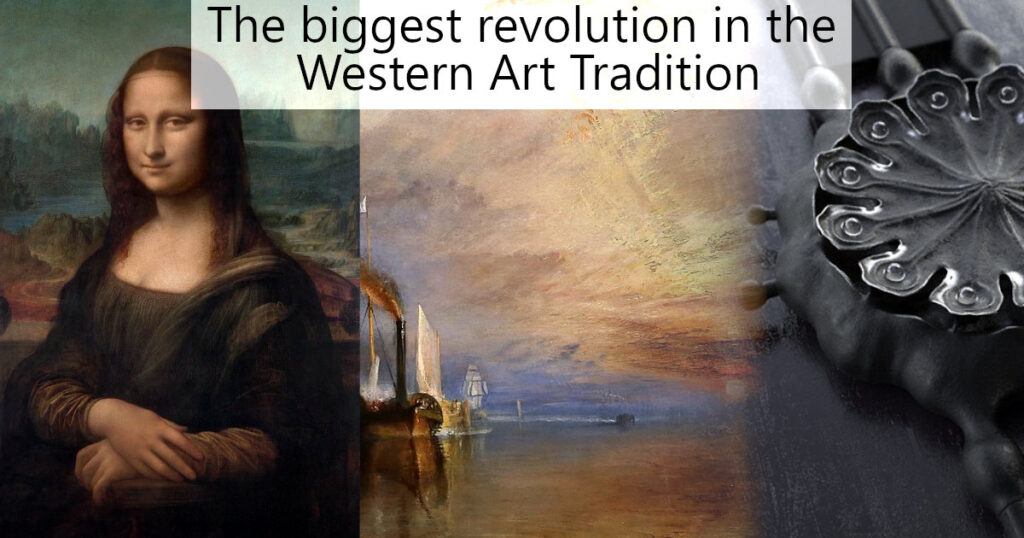
Sections in this article:
What is the Western Art Tradition?
The Western Art Tradition And Symbolic Representations
Definition of the concept this article is about:
Reaching the Edges of Symbolization
The Biggest Revolution in the Western Art Tradition?
Introduction
This articles clarifies what the Western Art Tradition is, looks at what can be called symbolic representations in Western music, then visual arts and jewelry.
We then look at what happens when the edges of the possibilities of this type of symbolization are reached, and what lies beyond symbolization.
We present the concept we’ve explored and clarified, as possibly being the biggest revolution in the Western Art Tradition, and invite your feedback on that question, and on anything else relevant.
Note that the main concept presented in this article seems to be regarded as “controversial” . . . although the points I present are fairly obvious once you’ve read about them in this article, it seems that what I am presenting as an overall concept is not part of the accepted perspectives on such things, so some people will just disagree with it because it’s different to the accepted views. I recommend you think through the points I am making and, as much as is possible, see what they add up to, from a neutral point of view, instead of looking from within the limitations of currently accepted theory.
What is the Western Art Tradition?
The Western Art Tradition refers to the evolution and development of art forms within the cultural, historical, and geographical context of Western civilization. It encompasses a vast array of artistic movements, styles, and periods originating primarily from Europe and later extending to North America.
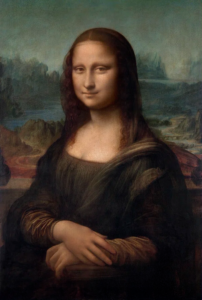
Although its roots can be traced to earlier times such as the great ancient civilizations of Greece and Rome, the main era of development of the Western Art Tradition is approximately the last thousand years or so, from the changes near the end of the middle ages, through Renaissance, Baroque, and Romantic periods to the great variety of modern and contemporary art movements. And it is, of course, very much still evolving as we speak.
The Western Art Tradition includes architecture, painting, sculpture, literature, music, and other forms of creative expression. There is an opinion that architecture is the most fundamental of the arts, and that new art movements can often be seen in architecture before the other arts.
It reflects, as well as contributing to, the development of societies it relates to. One of the most significant revolutions in its evolution was the Renaissance, which sparked a revival in art, science, and culture, emphasizing humanism and realism, and also rebelling against the existing traditions.
The whole of the Western Art Tradition can be seen as a continual process of evolution, constantly challenging the currently accepted norms and perspectives, expanding into new areas and exploring innovative possibilities. Morse Peckham said (in “Beyond the Tragic Vision; the quest for identity in the nineteenth century”) that an artist “presents a way of escaping from some conventions.”
While all the well-known revolutions in the arts of Europe and the North American continent are certainly significant, there is a single underlying concept fundamental to the whole of that evolution, which is almost entirely ignored, although I am sure it will seem obvious to you once I’ve explained it in detail during this article.
The Western Art Tradition And Symbolic Representations
Symbolic representations in music.
We’ll start with music, because it’s the most obvious example of this concept.
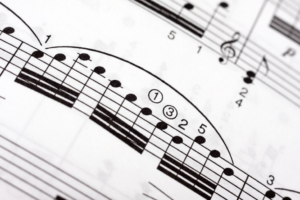
What music in the Western Art Tradition, (up until recent decades), is about, is musical notes. They are the form that music is represented in, and they correspond to a very fundamental property of most musical sounds as distinct from many natural sounds, which is the harmonic resonance of things like strings on a stringed instrument or columns of air in woodwind and brass instruments (percussion instruments are resonant, but with more complex harmonic systems).
These resonances are what Western Art Tradition music is all about, and are also about a fundamental mathematical perspective of this same period, which is ratios between numbers.
This concept is fundamental to both the musical notation used by classical composers, and to other forms of notation used in folk music or jazz, which all use the same system composed of notes specifying discrete pitch steps (from predefined musical scales) and divisions of duration.
The pitch element of musical notation, from notations used in about 1400 BCE, all the way up to MIDI (Musical Instrument Digital Interface), relates to musical scales, which are about simple mathematical ratios between pitches. Pythagoras discovered harmonic resonance by dividing vibrating strings into halves, thirds, quarters etc. which resulted in scales (when harmonics were transposed down to being within the same octave).
For example, the octave is the simplest ratio of the frequencies of resonances:1:2. This corresponds to a string half the length, or a column of air half the height. This simplest of ratios is the basis of musical scales – an octave. The pitch elements of notes, are based on a number of discrete steps within an octave.
The evolution of Western Art Tradition music can be seen as the development of making effective use of increasingly complex ratios (as well as an increasing interest in sound rather than notes). Although earlier forms of music used more notes from the scale, Plainsong was about embodying purity, using only the simplest ratios of 1:2 and 1:3. The ratio of 1:3 was even named a “perfect fifth” which reflects the perspective on it at the time.
After that the evolution of music gradually made use of more obscure and dissonant mathematical ratios between notes, first 3ds and 6ths, then 7ths and seconds, chromatic scales, increasingly complex modulations through different keys etc..
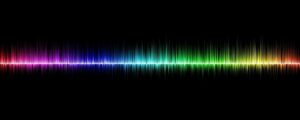
Within this single system, used for well over a thousand years, it makes sense to represent music as notes (even while, towards the end of that period, there was increasing focus on sound rather than notes). A note is a symbol for a sound, the sound itself being, in reality, very much more subtle and complex. The symbol represents only the most basic data, predefined by the system in which it is used, which in this case is about discrete pitch steps (scales) derived from simple ratios, and discrete divisions of duration.
An example of music being about notes more than sounds (until recently) is piano reductions of symphonies, which are obviously regarded as being the same symphony despite there being no sounds in common, because the symphony is more about the notes than the sounds.
Symbolic representations in visual art.
While, at first glance, the use of the exact same fundamental system might be less obvious in the visual arts, it is, in fact present to the same degree.
What is painted, drawn or sculpted, from the earliest cave paintings, all the way through the many stages of evolution of the visual arts, all the way to the early 20th Century, are only about recognizable objects. These objects might be people, animals, natural landscapes, tools or decorative objects, but they all have one thing in common: they can be named.
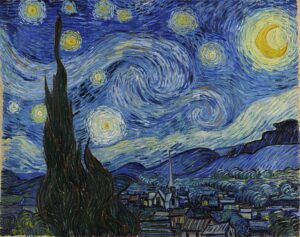
A name is a symbol for an object (from a language, which is a predefined set of labels).
In the same way that the actual sounds produced by musicians are vastly more complex than their symbolic representation as notes, the manifested results of painting, drawing or sculpture are vastly more complex than the words which name the objects they represent. But the focus is still all within the same system: the symbols.
Of course, there can be more than one layer of symbolization in a painting, as was usually the case with early art such as Greek and Roman art which used symbolism to depict mythological narratives, Medieval art employing symbols to convey theological concepts, and still often true later, with romantic symbolization such as lions representing nobility and tigers representing evil, or later works symbolizing political concepts. But it’s still all about the symbols.
So both visual arts, and musical expression in the Western Art Tradition, were both about things which are symbols. And, of course, literature uses words, which are symbols for the objects or concepts they represent.

Fine jewelry (which means all jewelry until the early 20th Century (except for fashion/costume jewelry which copies it with less expensive materials), and most jewelry since then) uses simple geometric shapes.
The concepts I have described above, can be defined more precisely . . .
Definition of the concept this article is about:
In the Western Art Tradition, after a gradual long-term increase in focus on increasingly complex sets of options and data, while still consistently including relatively simple datums from a pre-defined set of options, there was an absolute change:
This absolute change is a change from the use of relatively simple datums from a pre-defined set of options, to artworks which only use things which can only be realistically represented by data-sets of many times the magnitude of those simple datums.
Notes on that definition:
“relatively simple datums from a pre-defined set of options” refers to notes in music, which are from predefined scales, recognizable objects in visual art that the are words for (words come from a predefined language), and the simple geometric shapes that almost all fine jewelry is based on.
“things which can only be realistically represented by data-sets of many times the magnitude” refers to natural sounds such as the sound of the wind or a waterfall, to the results of abstract painting (for example the marks on canvas in a painting by Franz Kline do not represent objects that there are names for), and the complex organic, rough or broken forms and surfaces in art jewelry (see below for more on that topic).
I’ll give more details of this fascinating change, and how it relates to other aspects of society, below . . .
Reaching the Edges of Symbolization
The visual arts developed all the way to impressionism and paintings of artists like J.M.W. Turner (below), where there is very little emphasis remaining on the elements which obviously represent objects that there are words for (i.e. “ship”). If you removed the ship, you could see that the rest of the painting could be seen as abstract, with more focus on the marks and their results, than on what they represent.
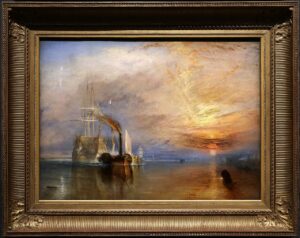
Music developed from the simplest 1:2 and 1:3 ratios in plainsong, all the way to 12-tone music in the early 20th Century, where every one of the twelve discrete steps on the equal-tempered scale is given equal importance, and then experimented with microtones, with increasing emphasis on the sound itself, through that progression. So where can you go from there? . . .
What Lies Beyond Symbols
in Western Art Tradition music, once you’ve got to 12-tone and microtones, there’s only one place left to explore.
In painting, once there’s almost no emphasis left on the objects which can be symbolized, there’s only one place left to explore.
And that only option once you’ve reached the limits of what lies inside the space of things that can be symbolized, is to let go of the use of symbols entirely . . .
This part of the journey is easier to see in the visual arts. It is abstract art, where the marks made are not used to represent a nameable object at all. This began with Vassily Kandinsky in 1910:
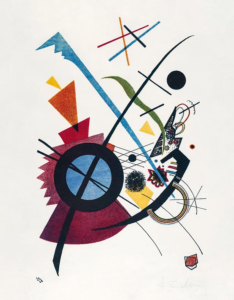
At around the same time, avant-garde music was moving deliberately beyond the convention of notes. An example is “4′33″ by John Cage, where the performer walks onto the stage, opens the lid of a piano, sites there without touching the piano for four minutes thirty-three seconds, then closes the lid of the piano signifying the end of the piece, so the music is the sounds in the concert hall during that time, with not a single note being used in the representation of that piece of music.
Another example is “music concrete”, which uses recorded sounds which cannot be represented effectively by musical notes (such as the sound of the wind, or a waterfall), to construct a piece of music. This move beyond notes, to sounds, is known in general as ambient music. (My paper on the Beginnings And Implications Of Ambient Music is here).
Perspectives on the development of this revolution
The development of the Western Art Tradition can be seen as being conceptually similar to the development of a child. Children start with art as symbols only. If you ask a young child to draw a person standing in front of them, they don’t look at the person, they draw a symbolic representation from their mind. It is only later that people are likely to learn to draw from what they see directly with their eyes, instead of using symbolic representations.
Finding ways to do this effectively can make a big difference to the aesthetic quality of the results. For example, if you draw a copy of a photo, the results might be OK. But if you turn the photo upside-down then copy it, the results are usually much better, because you are more likely to draw what you see rather than being influenced by the symbolic aspects of what you are recognizing as you look.
This can also be said to be the difference between design, and the fine art process. Design is creating something in your head, then manifesting that into material form. The fine art process fundamentally includes comparing your manifestations with objective reality, in an iterative manner (although not everyone agrees with this definition of fine art). The implications of this difference are profound, if you understand that what is stored in a mind is symbols.
The development of the Western Art Tradition can also be seen as going from living as part of dangerous, challenging natural world, through a thousand years of avoiding and taming nature, people moving into towns, and only then going back into nature and seeing it as beautiful and valuable in its own right rather than just a resource to be exploited without concern.
From advanced theory, it is known that awareness requires a differential. It is only when one has distanced oneself from nature, such as by moving to live in a town, that one will be able to truly see nature as it is, and appreciate it as something separate from one’s own life, as started to happen in the 20th Century. Such changes in perspective tend to apply much more at the level of a society, than an individual, as is obvious in this example.

During the majority of that era, religious perspectives dominated society, with their views dominating the arts, and involved avoiding the natural world where possible, considering the natural world as evil and as there only for heedless use by humans who should have most of their attention on things outside this world, such as symbols of higher realms.
Towards the end of that period, things were changing rapidly within a single lifetime. For example, famous America bird artist Audubon went from shooting around 100 birds a day to mount and paint, to being an avid conservationist.
Similar changes outside the arts
Suddenly, the natural world was seen (from an external perspective) as having value in its own right, as worthy of looking at rather than just seeing as nameable objects, and as being represented in the arts.
Improvements in technology were a significant part of the ambient music revolution, allowing recording and manipulations of sound from subtle changes in character to profound alterations and entirely new creations.
At the same time as abstract art and ambient music breaking free from the conventions of symbolization, societies were suddenly offering a very much wider range of options and sub-cultures.

While the revolutionary concept of valuing the natural world in its own right, and seeing it for what it is rather than just recognizing the symbols in it, were certainly ground-breaking at the time, these perspectives also relate to ancient concepts. For example, in Taoism one will learn the difference between just labeling things (i.e. symbolization) such as “that’s a sparrow” which means you then don’t look at what it is any more, compared to really looking at the details, beauty and wonder of the reality of the object itself.
Most of reality is fractal, and made of continual spectra (not divided into discrete notes). Human technology has so far focused almost exclusively on much simpler non-fractal forms and concepts, and aspects that can be broken into simple discrete steps.
In abstract art, the focus is usually on the complex, fractal aspects of the marks made, in their own right, not just as part of a symbol like the beautiful clouds in a painting of a recognizable landscape.
A similar change is seen in the development from fine-jewelry with its simple geometric shapes, to art jewelry, which often uses complex (non-symbolized) organic forms and deliberately rough, fractal textures, and is created by an individual as an artistic exploration (below is an example of one of our unique limited-edition art-jewelry watches):
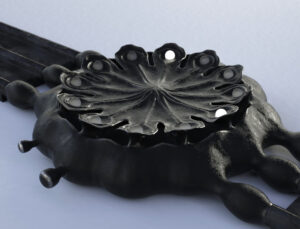
The fact that this revolution occurred at approximately the same time in the different arts, at the same time as major changes in society and technology suggest even bigger underlying influences.
The Biggest Revolution in the Western Art Tradition?
While the many commonly-known revolutions in the Western Art Tradition are clearly significant, it seems to me that the change from more than a thousand years of fundamental focus on a type of symbolization, to going beyond that whole conceptual system, is an even bigger revolution.
What do you think?
In case you’re reading this article on our website and haven’t yet noticed how it relates to our unique watches . . . in my opinion, we’re arguably the first conceptual-art-jewelry watch brand. Which makes us part of this same revolution.
Our watches obviously use organic forms (including 3D fractal forms, bottom right) and deliberately rough, complex textures like blackened silver, each UnconstrainedTime watch is by an individual creator focusing on chosen aesthetics (rather than conventional symbolic forms, mechanical influences and strongly archetypal time-displays). And our watches are also offered as small limited-editions:
And . . . our launch watch (bottom right, in the above images) can be seen as being even more part of this revolution, being probably the first ever watch based on a 3D fractal . . .
Don’t miss our launch!
. . . make sure you subscribe to our Priority List for notifications.
We welcome your comments on this blog post, and/or on our social media channels (see below) . . . do you think what I have described in this blog post, is the biggest revolution in the Western Art Tradition, or not???


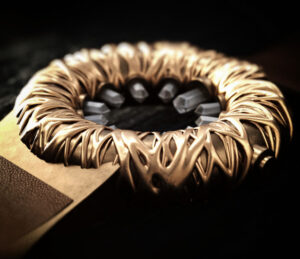


Leave a Reply